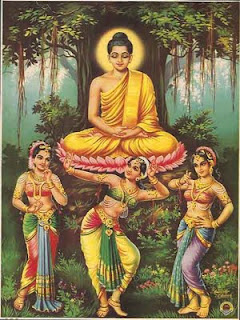Mara: The Buddhist Satan

The supernatural Mara is a sort of Satan in Buddhist literature. He is best known for his temptation of the historical Buddha. Equipped with sinister motives, he is the Buddhist devil. When the historical Buddha was sitting under the pipal tree awaiting Enlightenment, Mara tried all means to seduce him. First he disguised as a messenger and told Siddhartha that his father Suddhodhana had been put into prison by the Buddha’s wicked cousin Devadatta . This didn’t deter Siddhartha. Mara then called his armies of demon hosts to attack Gautama with earthquake and flood. Yet Siddhartha sat firm. When Mara challenged Siddhartha to produce evidence of his goodness, he touched the earth, and the earth itself spoke: "I am his witness.” Lastly Mara brought his three beautiful daughters ( Desire , Pleasure and Passion ) to seduce Siddhartha. This means also came to naught.





